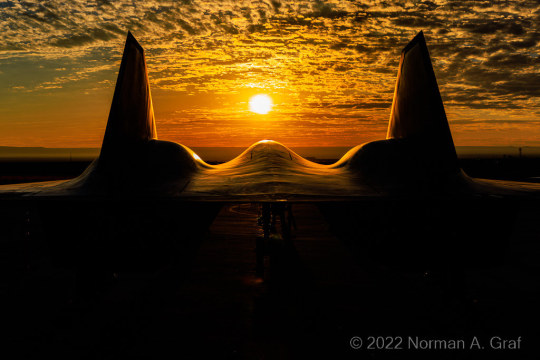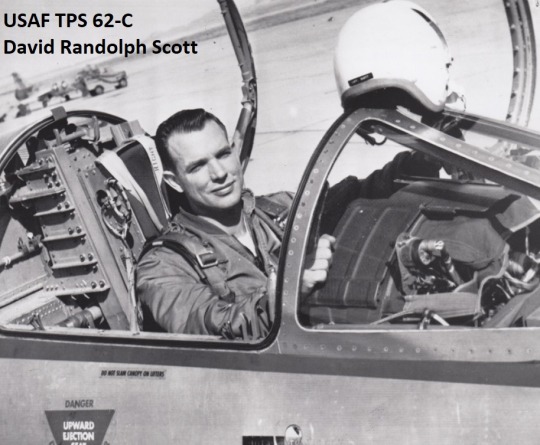#edwardsafb
Explore tagged Tumblr posts
Video
Lockheed YF-104A Starfighter by Benjamin Donnelly Via Flickr: The fourth of the 1950s era “Century Series,” the F-104 Starfighter was designed around one single element: speed. Clarence “Kelly” Johnson, head of Lockheed’s famous “Skunk Works” factory, had interviewed US Air Force pilots during the Korean War, seeking their input on any new fighter. Since the pilots reported that they wanted high performance more than anything else, Johnson returned to the United States determined to deliver exactly that: a simple, point-defense interceptor marrying the lightest airframe to the most powerful engine then available, the superb General Electric J79. When Johnson offered the L-098 design to the USAF in 1952, the service was so impressed that they created an entire competition for the aircraft to be accepted, ostensibly as a F-100 Super Sabre replacement. The Lockheed design had the clear edge, though both North American’s and Northrop’s design went on to be built themselves—the North American F-107A Ultra Sabre and the Northrop T-38 Talon. The USAF purchased the L-098 as the F-104A Starfighter. The design changed very little from initial design to prototype to operational aircraft, which was done in the astonishing time of two years. When the first F-104As reached the USAF in 1958, pilots quickly found that it was indeed a hot fighter—too hot. The Starfighter’s design philosophy of speed above all else resulted in an aircraft with a long fuselage, T-tail for stability, and small wings, which were so thin that special guards had to be put on the leading edges to avoid injuring ground personnel. Because of its small wing, the F-104 required a lot of runway, and blown flaps (which vents airflow from the engine over the flaps to increase lift) were a necessity; unfortunately, the airflow system often failed, which meant that the F-104 pilot would be coming in at a dangerous rate of speed. Because it was feared that a pilot who ejected from a F-104 would never clear the tail, a downward-ejection seat was fitted, but after killing over 20 pilots, the seat was retrofitted with a more reliable, upward-firing type. The design also was not very maneuverable in the horizontal, though it was difficult to match in the vertical. Its shape earned it the moniker “Missile With a Man In It” and “Zipper.” One thing pilots did not complain about was its speed—the listed top speed of the F-104 was Mach 2.2, but this was because above that the fuselage would melt. The J79 was a near flawless engine that gave the Starfighter an excellent thrust-to-weight ratio; uniquely, the intake design of the Starfighter gave the engine a bansheelike wail. So superb was the F-104 at level speed and climbing that NASA leased several as trainers for the X-15 program, and in setting a number of speed and time-to-climb records. If the F-104 had gotten a mixed reception at best in the USAF, Lockheed felt that it had potential as an export aircraft. Beating out several excellent British and other American designs in a 1961 competition, every NATO nation except France and Great Britain bought F-104s and manufactured their own as the F-104G; Japan also license-built Starfighters as F-104Js, while still more were supplied to Pakistan and Taiwan. Just as in USAF service, accident rates were incredibly high, particularly in West German and Canadian service—Germany lost 30 percent of its initial batch, and the Canadians over half. Worries that the F-104 was too “hot” for pilots usually transitioning from the F-86 were ignored, and later it was learned why: German, Dutch, and Japanese politicians later admitted to being bribed by Lockheed into buying the Starfighter. Its high accident rate earned such nicknames as “Widowmaker,” “Flying Coffin,” and “Ground Nail.” Pakistani pilots simply called it Badmash (“Criminal”) and the Japanese Eiko (“Glory,” inferring that it was the easiest way to reach it). German pilots joked that the quickest way to obtain a F-104 was to buy a patch of land and wait. Nonetheless, once pilots learned how to tame the beast, the accident rates eased somewhat, and NATO pilots discovered that the Starfighter excelled as a low-level attack aircraft: fitted with bomb racks, the F-104 was remarkably stable at low altitude and high speed, and Luftwaffe pilots in particular found that they could sneak up on a target, launch a simulated attack, and be gone before ground defenses could react. The Italians in particular loved the F-104, building their own as the F-104S: these aircraft were equipped with multimode radar and armed with AIM-7 Sparrow and Aspide radar-guided missiles, making them a superb interceptor. Though most NATO nations reequipped their F-104 units with F-16s, F-18s, or Tornados beginning in 1980, the Italian F-104S fleet was continually upgraded and soldiered on until final retirement in 2004. 2578 F-104s were built, mostly F-104Gs; today over 150 survive in museums, with at least ten flyable examples, making it one of the best preserved of the Century Series. The second oldest F-104 left (only the YF-104A in the National Air and Space Museum is older), 55-2967 was delivered to the USAF as one of 17 YF-104 pre-production aircraft--and one of only two left, as the others were either expended as drones or crashed during testing. 55-2967 never served in a frontline or ANG unit: it went directly to Air Force Systems Command at Edwards AFB, California, in 1956. It only flew for a year before it was heavily damaged in a bad landing at Bergstrom AFB, Texas. 55-2967 would never fly again, but rather than scrap it, it was turned into a GF-104A ground instruction trainer. Ironically, the hard landing that grounded 55-2967 saved it from the fate of the other YF-104s, and in the late 1960s, as the F-104 was phased out of USAF service, it was put on display on the cadet grounds at the US Air Force Academy in Colorado Springs. However, the airframe suffered from being out in the open, and the AFA wanted to replace it with something of a little newer vintage. It was then donated to the Pueblo Weisbrod Museum, and trucked down to its new home. It was restored and moved inside in 2011. When I got the picture, I didn't realize this was either a YF-104 or that I'd almost certainly seen it as a kid when Dad and I visited the AFA on several occasions. Though few if any USAF F-104s flew in overall ADC Gray, this better preserves the aircraft; the font is also incorrect, but that's a nitpick on an excellent preservation job. A Tactical Air Command patch is carried on the tail. I always love being reacquainted with aircraft I would've seen when I was little!
#Lockheed#F-104#YF-104A#EdwardsAFB#USAF#ColdWar#testaircraft#prototype#fighter#aircraft#PuebloWeisbrodMuseum#flickr
19 notes
·
View notes
Text

Happy #FighterFriday! The seasons change, but our readiness remains at 💯.
Our 416th FLTS, continues to provide safety, photo and target support in addition to #USAF / FMS Viper upgrades with weapons, sensors and avionics.



No rest for test... SKULLS RULE! 💀 #AFMC
@EdwardsAFB via X
#f 16#f16#f16 fighter jet#f 16 fighting falcon#f16viper#lockheed martin#fighter bomber#aircraft#usaf#aviation#cold war aircraft#fighter
20 notes
·
View notes
Photo

A new dawn... by Norman Graf https://flic.kr/p/2nUaGrd
4 notes
·
View notes
Photo

June 6, 2020, Congratz 88th birthday to astronaut David R. Scott! David Scott, a West Point graduate who joined the Air Force in 1954, served as a fighter pilot at Soesterberg - the Netherlands during the height of the Cold War before graduating as Test pilot of class 62-C at the Test Pilot School at Edwards Air Force base. The photo shows Scott in the cockpit of a Lockheed F-104 Starfighter. Scott was selected in NASA astronaut group 3 and went on to fly on Gemini VIII, Apollo 9 and the 7th person to walk on the Moon during Apollo 15. In 1993, David Scott was inducted in the US Astronaut Hall of Fame at the Kennedy space center - Florida. (Photo: USAF)
#DavidScott#Apollo#aviator#AFAFTC#USAFTPS#chronograph#EdwardsAFB#USMA#NASA#Navy#USAF#military#pilot#fighterjock#Lockheed#Starfighter#F-104#CenturySeries#spaceflight#Soesterberg#Wristwatch#Westpoint#moonwatchUniverse#Moonwalk#MIT#Moonbuggy#Testpilot#Jetpilot#EjectionSeat#TheRightStuff
24 notes
·
View notes
Photo

Stopping by to see an old friend. The Space Shuttle Transporter. #ShuttleTransporter #spaceshuttleprogram #NASA #Boeing747 #FormerlyJAL #AirplaneGraveYard #CityOfLancaster #EdwardsAFB #CaliforniaAeroSpaceIndustry #SpaceShuttle #palmdaleca (at Joe Davies Heritage Airpark) https://www.instagram.com/p/BvW1ZApHqwo/?utm_source=ig_tumblr_share&igshid=1vjxnq8b5ihjy
#shuttletransporter#spaceshuttleprogram#nasa#boeing747#formerlyjal#airplanegraveyard#cityoflancaster#edwardsafb#californiaaerospaceindustry#spaceshuttle#palmdaleca
1 note
·
View note
Photo

Test Stand 1-D at Edwards Air Force Base, California. Originally built to test the F-1 engine for the Saturn V moon rocket in the 1960s.
For more information, see: https://www.willylogan.com/?p=2543
0 notes
Photo

1962, test pilot Neil Armstrong flew 7 X-15 flights before being selected for NASA astronaut group 2. Note he was wearing an Accutron Astronaut wrist watch strapped over his left forearm. (Photo: NASA)
#X-15#Astronaut#Armstrong#Accutron#Bulova#EdwardsAFB#NASA#Navy#USAF#Hypersonic#Aviation#Spaceflight#vintagewatches#wristwatch#watchblog#Testpilot#DavidClark#Spacesuit#WatchMakingHistory#TuningFork#USmade
3 notes
·
View notes
Photo

The US Air Force Rules of Engagement for filming at Edwards AFB. No spitting peanut shells, skateboards or wearing flip-flops. Goddamn millenials. #usairforce #usaf #rulesofengagement #edwardsafb #peanutsofinstagram #foiabinladen #hollywood https://www.instagram.com/p/BzbLxTFJrxR/?igshid=pderxs6ngzwb
0 notes
Photo

Seeing as my Starbucks is closing for renovations at the end of the week until the middle of November (SERIOUSLY, closing during the fall!?!) and I live in the middle of nowhere 🌵 I figured I'd have one last hurrah and enjoy some fall goodness even though it's still in the 90s here. #psl #starbucks #edwardsafb #desertliving #nyxenjoysnappinginthebackground
0 notes
Text

The trifecta is BACK.
#ICYMI- Our teams with the 419th FLTS welcomed back the B-2 to flight test, launching a new era of upgrades & experiments aimed at maintaining the Spirits capabilities into the next decade. #AFMC #USAF
@EdwardsAFB via X
#b 52 stratofortress#b 1b lancer#b2a spirit#bombers#nuclear weapons#aircraft#usaf#aviation#cold war aircraft
30 notes
·
View notes
Photo


Stunning NEW "Edwards AFB 416th Flight Test Squadron" vintage style military aviation art by - Squadron Posters!
The 416th Flight Test Squadron (416 FLTS) is part of the 412th Test Wing at Edwards AFB, California. They do flight testing for the F-16 Fighting Falcon as well as support other airframes at Edwards including the F-35 and F-22. Some of the amazing programs to come out of this squadron include ground "collision avoidance technology" which enables the F-16 to avoid colliding with the ground when the pilot is incapacitated. Read more and get your copy here: http://www.squadronposters.com/product/edwards-afb-416th-flts/
At Squadron Posters, we turn Military Bases into vintage themed Travel Posters that are: “Man Cave Worthy and Spouse Approved!” Collect all your travels and tell your story! http://www.squadronposters.com/
At Squadron Books, we simply tell you story! http://www.squadronbooks.com/home-page/
Want a NEW design? See how here: http://www.squadronposters.com/art/
0 notes
Photo

S69-31742 was West Point graduate & USAF test pilot Michael Collins’ third official NASA portrait. In October 1963, Michael Collins was among ‘ The Fourteen “ new fighter pilots selected as NASA astronauts as part of Group 3. In July 1966, Collins flew onboard Gemini X mission, performing two spacealks and the first NASA astronaut to wear a wristwatch, his NASA-issued Omega Speedmaster, underneath a spacesuit. More interesting, is the fact pointed out by Rolexmagazine, that Apollo 11 Command Module Pilot Michael Collins was wearing his personal Rolex wristwatch in this White Space Suit portrait. Looking closely, the turnable bezel of his Rolex Turn-O-Graph pilot watch is just visible above his hand. Since 1964, Michael Collins, who usually wore his watch on the righthand wrist, often wore his Rolex Turn-O-Graph during Gemini & Apollo training. The May 20, 1969 Saturn V rocket roll-out to launchpad 39A among the best-known photos. (Photo: NASA)
#Rolex#Astronaut#aviator#Rolexwatches#RolexMagazine#Apollo#ASE#EdwardsAFB#Gemini#horology#vintageRolex#Turn-O-Graph#NorthAmericanAviation#military#montres#moonwatch#moonwatchUniverse#NASA#Navy#USMC#USAF#Colonel#pilotwatch#fighterpilot#jetpilot#testpilot#AFAFTC#ARPS#spacesuit#spaceflight
12 notes
·
View notes
Text
The latest The Blog Daily! https://t.co/zcMr07ySI4 Thanks to @EdwardsAFB #contentmarketing #unitedstates
Blogging Informer and Alex Collins have posted the tweet with the following content:
The latest The Blog Daily! https://t.co/zcMr07ySI4 Thanks to @EdwardsAFB #contentmarketing #unitedstates
— Alex Collins (@BloggingJMC) August 14, 2019
This article is published on August 15, 2019 at 12:37AM Please be noted that the following article is available on Alex Collins's WordPress. Content credit: visit on Twitter
This article is available on here and it is republished on Sophia Borel's Tumblr.
0 notes
Text
The latest The Blog Daily! https://t.co/zcMr07ySI4 Thanks to @EdwardsAFB #contentmarketing #unitedstates
Blogging Informer and Alex Collins share new tweet with the following content:
The latest The Blog Daily! https://t.co/zcMr07ySI4 Thanks to @EdwardsAFB #contentmarketing #unitedstates
— Alex Collins (@BloggingJMC) August 14, 2019
This following article is published on August 15, 2019 at 12:37AM Please be noted that the following article is available on Alex Collins's Blogger. Content credit: see more on Twitter
0 notes
Text
The latest The Blog Daily! https://t.co/zcMr07ySI4 Thanks to @EdwardsAFB #contentmarketing #unitedstates
Blogging Informer and Alex Collins have posted a tweet with the following content:
The latest The Blog Daily! https://t.co/zcMr07ySI4 Thanks to @EdwardsAFB #contentmarketing #unitedstates
— Alex Collins (@BloggingJMC) August 14, 2019
This article is published on August 15, 2019 at 12:37AM Please be noted that the following article is available on Alex Collins's Weebly. Content credit: find out on Twitter The following article is available on click here and it is originally published to Bill Vera's Blogger.
0 notes
Photo

1962, test pilot Neil Armstrong flew 7 X-15 flights before being selected for NASA astronaut group 2. Note he was wearing an Accutron Astronaut tuning fork “hummer” wrist watch on his left forearm. (Photo: NASA)
#X-15#Accutron#Astronaut#Bulova#Armstrong#DavidClark#EdwardsAFB#spacesuit#Hypersonic#aviation#spaceflight#NASA#Navy#USAF#Testpilot#vintagewatches#wristwatch#USmade#TuningFork#watchmakinghistory#MoonwatchUniverse
2 notes
·
View notes
